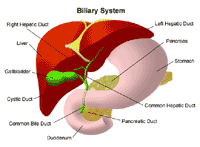Hepatitis C
 |
| Click Image to Enlarge |
What is hepatitis?
The liver is one of the organs that helps with digestion but is not part of the digestive tract. It is the largest organ in the body and carries out many important functions, such as making bile, changing food into energy, and cleaning alcohol and poisons from the blood.
Hepatitis is inflammation of the liver that sometimes causes permanent damage. It is most commonly caused by viruses, bacteria, certain medications, or alcohol. It may also be caused by certain diseases, such as autoimmune diseases, metabolic diseases, and congenital (present at birth) abnormalities (biliary atresia, Wilson disease). Generally, symptoms of hepatitis include fever, jaundice, and an enlarged liver. There are several types of hepatitis.
What is hepatitis C?
Hepatitis C (known as HCV, once called non-A, non-B hepatitis) is a liver disease caused by a bloodborne virus. Discovered in 1989, this strain of acute viral hepatitis causes approximately 20,000 new infections in the U.S. each year.
Recovery from this infection is rare--about 75 to 85 percent of infected people become chronic carriers of the virus. Approximately 20 percent of people infected with hepatitis C virus will become sick with jaundice or other symptoms of hepatitis. Sixty to 70 percent of these people may go on to develop chronic liver disease.
Chronic liver disease due to hepatitis C causes between 8,000 and 10,000 deaths and is the leading indication for liver transplantation each year in the United States.
What causes hepatitis C?
Transmission of hepatitis C occurs primarily from contact with infected blood, but can also occur from sexual contact or from an infected mother to her baby. Blood transfusions prior to 1992 and the use of shared needles are other significant causes of the spread of hepatitis C.
Who is at risk for hepatitis C?
The following describes people who may be at risk for contracting hepatitis C:
-
Children born to mothers who are infected with the virus
-
People who have a blood-clotting disorder, such as hemophilia and received clotting factors before 1987
-
People who require dialysis for kidney failure
-
People who received a blood transfusion before 1992
There is no vaccine for hepatitis C. People who are at risk should be checked regularly for hepatitis C. People who have hepatitis C should be monitored closely for signs of chronic hepatitis and liver failure.
What are the symptoms of hepatitis C?
The following are the most common symptoms for hepatitis C. However, each individual may experience symptoms differently. Symptoms may include:
Symptoms may occur from two weeks to many months after exposure. The symptoms of hepatitis C may resemble other medical conditions or problems. Always consult your doctor for a diagnosis.
How is hepatitis C diagnosed?
In addition to a complete medical history and physical examination, diagnostic procedures for hepatitis C may include the following:
Treatment for hepatitis C
Specific treatment for hepatitis C will be determined by your doctor based on:
-
Your age, overall health, and medical history
-
Extent of the disease
-
Your tolerance for specific medications, procedures, or therapies
-
Expectations for the course of the disease
-
Your opinion or preference
At the present time, a vaccine is not available for the prevention of hepatitis C. Treatment may include biological therapy with interferon.